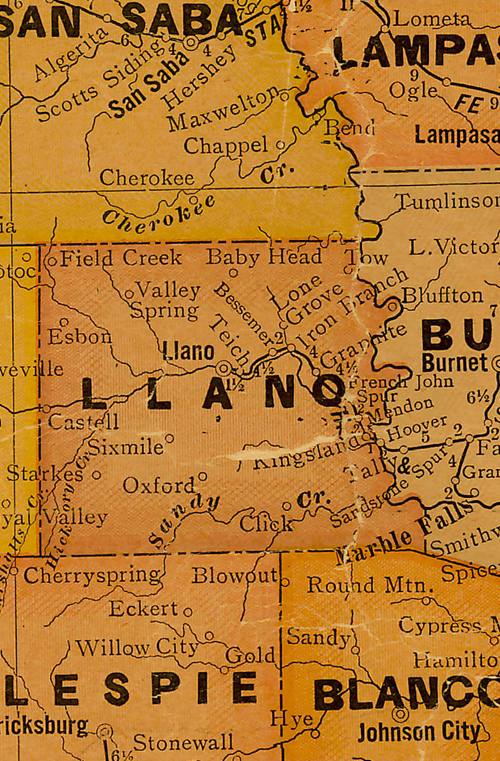|
|
In
June 1939, on the occasion of his golden wedding anniversary, 75-year-old
Henry Smith reflected on the happiness he had found in life and
something else he had not found — a lost mine.
He'd spent a fair amount of time in his younger years looking for
it, but he never found it. Smith had not wasted his time seeking
the granddaddy of all lost Texas mines, the Spanish silver works
Jim Bowie supposedly discovered in the early 1830s somewhere near
the old mission in Menard
County. Folks are still searching for that mine, but the other
old mine pretty much has been forgotten. It was a lead mine.
Lead is not the most precious of minerals, but along the Texas frontier
it was pretty important when muzzle loading rifles and pistols fired
homemade lead balls. Lead for bullet molding was available commercially,
of course, but a handy vein of ore saved money and time.
Llano County pioneer
Billy Nard discovered the vein and began working it in the 1860s.
With the Indians taking advantage of the fact that most of the menfolks
were off fighting Yankees, lead was particularly important in areas
prone to moonlight raids. In fact, when Comanches came calling,
lead was worth more than silver or gold.
No prospector, Nard made a simple living as a bee and commercial
deer hunter. He wasn't interested in bees per se, but they led him
to honey combs. He gathered and sold honey along with venison.
His wife later recalled that he usually left their cabin with a
sack over his shoulder, a hatchet and his muzzle loader. He came
home with honey and deer meat often enough to make ends meet. Less
frequently, based on need, he returned to their homestead with a
sack full of lead ore.
Nard molded bullets from the melted ore and shared the lead with
his neighbors at no cost. A man could live without honey, but at
this stage of Texas' history, bullets were no luxury.
Despite his willingness to share his ore, Nard carefully guarded
the location of his mine. He varied the routes he took to and from
his diggings to make it hard for anyone to follow him. He didn't
even tell his wife, though he promised to reveal the location of
the lead deposit to his children before he died.
|
 |
1920s Llano
County map showing Sandy Creek
From Texas
state map #10749
Courtesy Texas General Land Office |
|
Unfortunately,
that death came sooner than Nard or anyone in his family expected.
Indians killed him, but not directly. With one of his boys and his
brother-in-law (Henry Smith's uncle), Nard was hunting wild hogs
on Silver Creek, a tributary of Sandy Creek, when Indians surprised
the party.
Grabbing up
his nine-year-old son, Nard ran hell-for-leather toward his cabin.
In doing so, he slogged through deep sand in the creek bed. Stout
to the point of fleshiness, Nard escaped the Indians red faced and
panting. For whatever reason, he had opted flight over using some
of the bullets from his secret lead mine.
Two days later, untouched by arrow or bullet, Nard died, probably
of a heart attack triggered by the shock of the encounter coupled
with the exertion of his run.
The location of his lead honey hole died with him.
As a youngster Smith had helped his father mold bullets from the
ore supplied by Nard. He recalled that the lead made suitable bullets,
but it was not of as high a quality as commercially available lead.
After Nard died, his widow and children moved in with the Smith
family. When Henry Smith got old enough to prowl around by himself,
he tried without success to find the mine. His best guess, based
on where Nard had his cabin, was that the ore vein was somewhere
near Sandy Creek. Others said it was near Cedar Mountain while some
maintained the mine was along Honey Creek.
Smith wasn't the only one interested in finding the mine. Llano
County rancher Tom Moore had a standing offer of $500 for the person
who found it, but no one ever collected.
Too bad no one ever thought to look at a 103-page U.S. Geological
Survey report published in 1911, "Mineral Resources of the Llano-Burnet
Region, Texas." Written by Sidney Page based on field work he and
several other geologists did in 1908-1909, the report is not ambiguous
on whether lead ore (galena) could be found in Llano
County. Not only did the geologists locate deposits of galena,
they noted evidence of old mining activity at each of the two locations
they discovered.
One of those well could have been the mine Nard had succeeded so
well in keeping hidden.
|
| Books
by Mike Cox - Order Here |
|
|
